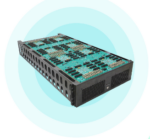Efinix announced a line of FPGA solutions designed specifically for the automotive industry to drive forward the long-term design and development of the rapidly growing numbers of electronic applications in-and-outside vehicles. The line, now automotive qualified, and Efinix’s Efinity tool suite that has achieved ISO26262 certification extend the company’s capabilities for automotive manufacturers. The FPGA solutions for […]
FPGA
eFPGA development tool suite supports all major HDL languages
QuickLogic Corporation has released a new version of its Aurora eFPGA development tool suite. The Aurora 2.1 Development Tool Suite is based on a fully open-source implementation for scalability, longevity, and full code transparency. It supports all major HDLs including Verilog, System Verilog, and VHDL. The new version is based on open-source synthesis (Yosys), Versatile […]
FPGA machine vision platform carries AMD Xilinx Kria K26 SOM
Innodisk announced its latest step into the AI market with the launch of EXMU-X261, an FPGA Machine Vision Platform. Powered by AMD’s Xilinx Kria K26 SOM, which was designed to enable smart city and smart factory applications, Innodisk’s FPGA Machine Vision Platform is set to lead the way for industrial system integrators looking to develop […]
DSP IP for FPGAs handles full C-PHY 2.0 speeds
Arasan has released an all-new version of its MIPI DSI IP compliant with the DSI-2 v1.0 Specifications supporting C-PHY v2.0 speeds of up to 54.72Gbps operating at 8 Gbps (for 1channel) for FPGA designs. This IP is designed to meet FPGA timing limitations to run at slower frequencies at less than 200 Mhz while still […]
eFPGA IP core now available on 7 nm tech node
Flex Logix Technologies, Inc. announced that it has completed porting and delivered the EFLX4K eFPGA IP core, both the Logic and DSP versions, on TSMC 7nm technology to its lead customer for integration into a production ASIC. By making eFPGA technology available in 7nm with the leading foundry, customers can now develop devices with integrated […]
What do MCUs have that FPGAs don’t?
Microcontroller units (MCUs) have a computer processor unit (CPU) core, various types of memory, input/output (I/O) functions, and a range of integrated peripherals. Field programmable gate arrays (FPGAs) don’t have any of these features and consist of many configurable (or programmable) logic blocks, with a programmable interconnect overlay surrounded by numerous general purpose I/Os (GPIOs). […]
Software helps manage FPGA-based prototyping
S2C announces Neuro, a software program providing comprehensive management capabilities for enterprise-wide prototyping environments. Through a flexible browser-based interface, Neuro delivers a host of management and control capabilities covering four executive functions: User Management – this includes setting up user accounts, defining groups, assigning managers, and setting access permissions. Resource Management – provides resource allocation […]
FPGA prototyping software features multi-FPGA support
S2C announced the release of its enriched prototyping software dubbed Prodigy Player Pro-7. The new software suite breaks out Player Pro-RunTime, to strengthen prototype platform control and hardware test for its high-capacity platforms; Player Pro-CompileTime, to enhance the automation of multi-FPGA partitioning and pre/post-partition timing analysis; and Player Pro-DebugTime, to improve the efficiency of multi-FPGA debug probing and trace […]
SRAM PUF-based security IP protects Intel FPGAs
Intrinsic announced the immediate availability of its SRAM PUF-based hardware IP “QuiddiKey for Intel FPGAs”. QuiddiKey for Intel FPGAs is device-level security IP that comes pre-integrated as part of the security infrastructure of several Intel FPGA families. It creates a more secure platform by providing access to Intrinsic ID’s SRAM PUF technology on the FPGAs. […]
FPGAs deliver more, memory, logic, and security
Lattice Semiconductor extended its long-standing leadership in control of FPGAs with the introduction of the Lattice MachXO5-NX family, the fifth device built on the award-winning Lattice Nexus platform. MachXO5-NX FPGAs enable the latest generation of secure control through increased logic and memory resources, robust 3.3 V I/O support, and a differentiated security feature set. Designed […]










